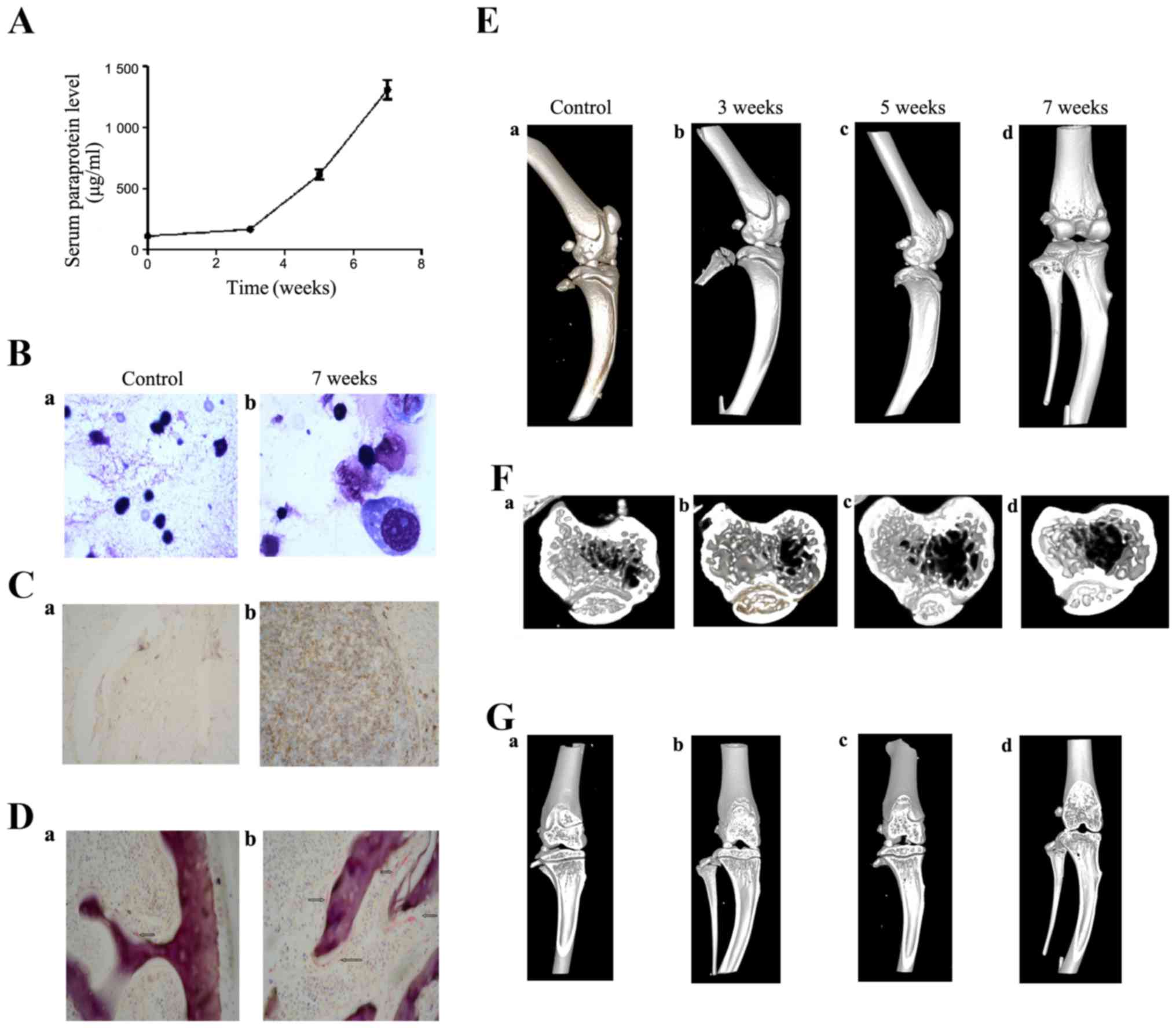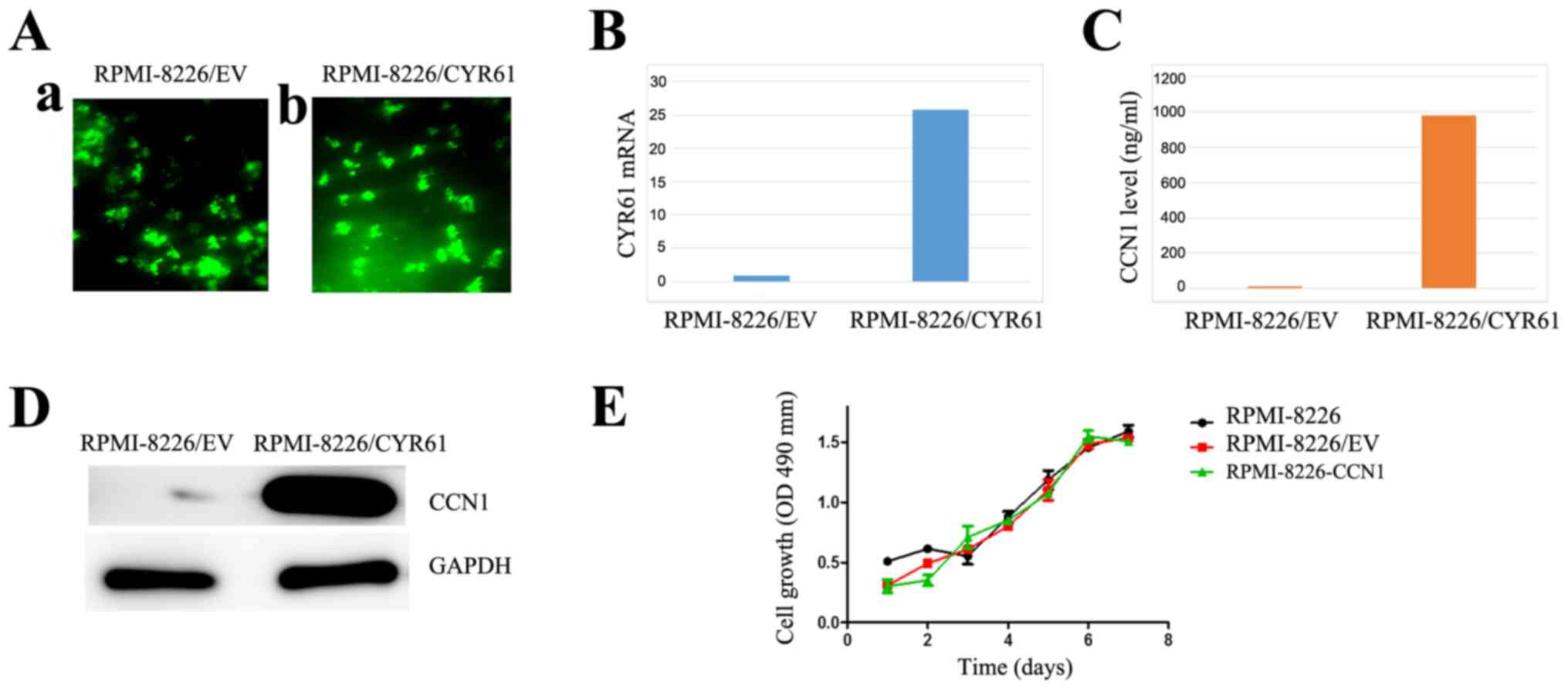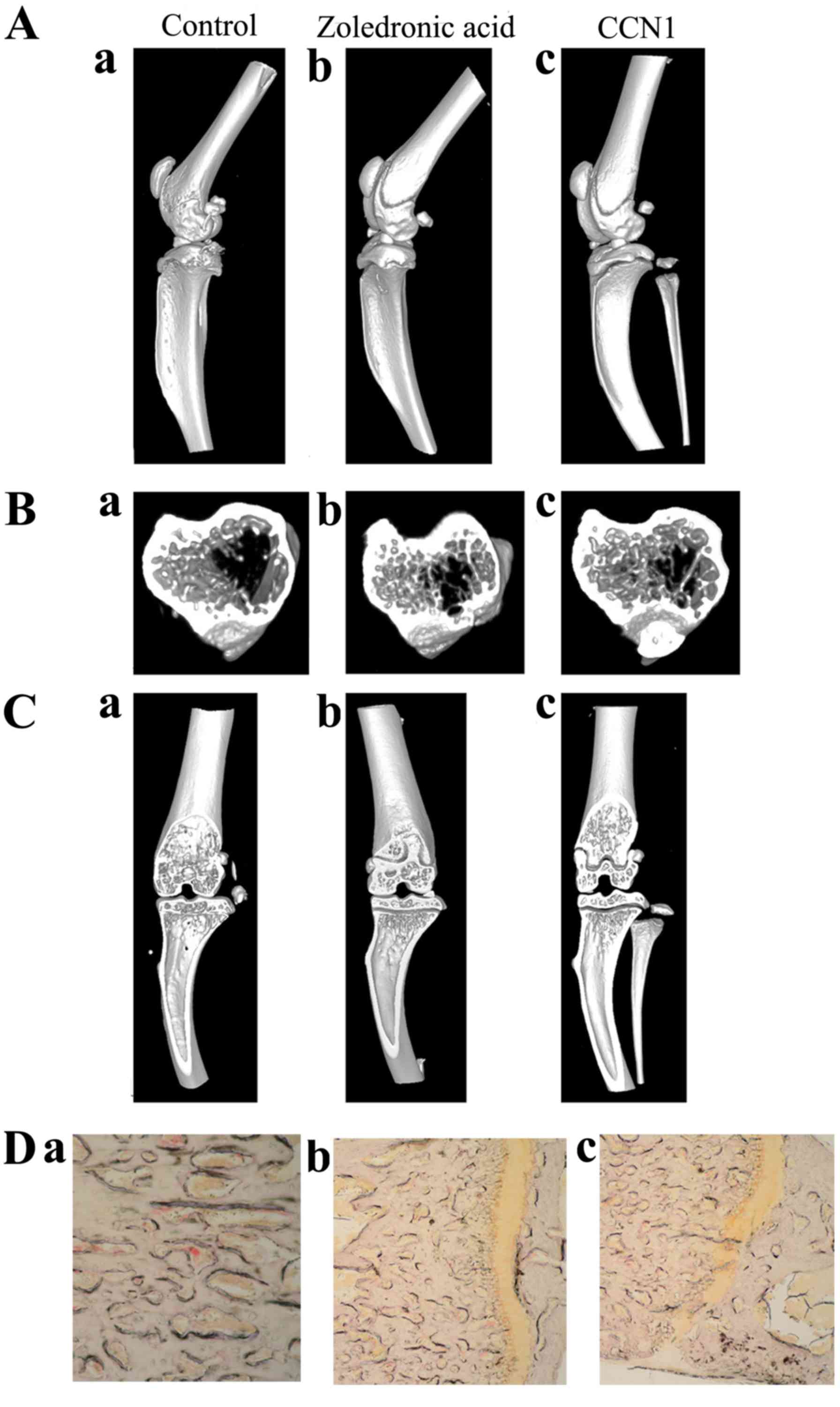|
1
|
Anderson KC: Oncogenomics to target
myeloma in the bone marrow microenvironment. Clin Cancer Res.
17:1225–1233. 2011. View Article : Google Scholar : PubMed/NCBI
|
|
2
|
Yaccoby S: Osteoblastogenesis and tumor
growth in myeloma. Leuk Lymphoma. 51:213–220. 2010. View Article : Google Scholar :
|
|
3
|
Vallet S, Smith MR and Raje N: Novel
bone-targeted strategies in oncology. Clin Cancer Res.
16:4084–4093. 2010. View Article : Google Scholar : PubMed/NCBI
|
|
4
|
Boyce BF and Xing L: The RANKL/RANK/OPG
pathway. Curr Osteoporos Rep. 5:98–104. 2007. View Article : Google Scholar : PubMed/NCBI
|
|
5
|
Vallet S, Pozzi S, Patel K, Vaghela N,
Fulciniti MT, Veiby P, Hideshima T, Santo L, Cirstea D, Scadden DT,
et al: A novel role for CCL3 (MIP-1α) in myeloma-induced bone
disease via osteocalcin downregulation and inhibition of osteoblast
function. Leukemia. 25:1174–1181. 2011. View Article : Google Scholar : PubMed/NCBI
|
|
6
|
Fu R, Liu H, Zhao S, Wang Y, Li L, Gao S,
Ruan E, Wang G, Wang H, Song J, et al: Osteoblast inhibition by
chemokine cytokine ligand3 in myeloma-induced bone disease. Cancer
Cell Int. 12:1322014. View Article : Google Scholar
|
|
7
|
Scullen T, Santo L, Vallet S, Fulciniti M,
Eda H, Cirstea D, Patel K, Nemani N, Yee A, Mahindra A, et al:
Lenalidomide in combination with an activin A-neutralizing
antibody: Preclinical rationale for a novel anti-myeloma strategy.
Leukemia. 27:1715–1721. 2013. View Article : Google Scholar : PubMed/NCBI
|
|
8
|
Kristensen IB, Christensen JH, Lyng MB,
Møller MB, Pedersen L, Rasmussen LM, Ditzel HJ and Abildgaard N:
Hepatocyte growth factor pathway upregulation in the bone marrow
microenvironment in multiple myeloma is associated with lytic bone
disease. Br J Haematol. 161:373–382. 2013. View Article : Google Scholar : PubMed/NCBI
|
|
9
|
Hiasa M, Teramachi J, Oda A, Amachi R,
Harada T, Nakamura S, Miki H, Fujii S, Kagawa K, Watanabe K, et al:
Pim-2 kinase is an important target of treatment for tumor
progression and bone loss in myeloma. Leukemia. 29:207–217. 2015.
View Article : Google Scholar
|
|
10
|
Johnson SK, Stewart JP, Bam R, Qu P,
Barlogie B, van Rhee F, Shaughnessy JD Jr, Epstein J and Yaccoby S:
CYR61/CCN1 overexpression in the myeloma microenvironment is
associated with superior survival and reduced bone disease. Blood.
124:2051–2060. 2014. View Article : Google Scholar : PubMed/NCBI
|
|
11
|
Perbal B: CCN proteins: Multifunctional
signalling regulators. Lancet. 363:62–64. 2004. View Article : Google Scholar : PubMed/NCBI
|
|
12
|
Kireeva ML, Mo FE, Yang GP and Lau LF:
Cyr61, a product of a growth factor-inducible immediate-early gene,
promotes cell proliferation, migration, and adhesion. Mol Cell
Biol. 16:1326–1334. 1996. View Article : Google Scholar : PubMed/NCBI
|
|
13
|
Clines GA, Mohammad KS, Bao Y, Stephens
OW, Suva LJ, Shaughnessy JD Jr, Fox JW, Chirgwin JM and Guise TA:
Dickkopf homolog 1 mediates endothelin-1-stimulated new bone
formation. Mol Endocrinol. 21:486–498. 2007. View Article : Google Scholar :
|
|
14
|
Si W, Kang Q, Luu HH, Park JK, Luo Q, Song
WX, Jiang W, Luo X, Li X, Yin H, et al: CCN1/Cyr61 is regulated by
the canonical Wnt signal and plays an important role in
Wnt3A-induced osteoblast differentiation of mesenchymal stem cells.
Mol Cell Biol. 26:2955–2964. 2006. View Article : Google Scholar : PubMed/NCBI
|
|
15
|
Su JL, Chiou J, Tang CH, Zhao M, Tsai CH,
Chen PS, Chang YW, Chien MH, Peng CY, Hsiao M, et al: CYR61
regulates BMP-2-dependent osteoblast differentiation through alpha
v beta 3 integrin/ILK/ERK pathway. J Biol Chem. 285:31325–31326.
2010. View Article : Google Scholar : PubMed/NCBI
|
|
16
|
Chen CY, Su CM, Huang YL, Tsai CH, Fuh LJ
and Tang CH: CCN1 induces oncostatin M production in osteoblasts
via integrin-dependent signal pathways. PLoS One. 9:e1066322014.
View Article : Google Scholar : PubMed/NCBI
|
|
17
|
Terpos E, de la Fuente J, Szydlo R,
Hatjiharissi E, Viniou N, Meletis J, Yataganas X, Goldman JM and
Rahemtulla A: Tartrate-resistant acid phosphatase isoform 5b: A
novel serum marker for monitoring bone disease in multiple myeloma.
Int J Cancer. 106:455–457. 2003. View Article : Google Scholar : PubMed/NCBI
|
|
18
|
Li X, Pennisi A and Yaccoby S: Role of
decorin in the antimyeloma effects of osteoblasts. Blood.
112:159–168. 2008. View Article : Google Scholar : PubMed/NCBI
|
|
19
|
Labrinidis A, Diamond P, Martin S, Hay S,
Liapis V, Zinonos I, Sims NA, Atkins GJ, Vincent C, Ponomarev V, et
al: Apo2L/TRAIL inhibits tumor growth and bone destruction in a
murine model of multiple myeloma. Clin Cancer Res. 15:1998–2009.
2009. View Article : Google Scholar : PubMed/NCBI
|
|
20
|
Schwarzer R, Nickel N, Godau J, Willie BM,
Duda GN, Schwarzer R, Cirovic B, Leutz A, Manz R, Bogen B, et al:
Notch pathway inhibition controls myeloma bone disease in the
murine MOPC315.BM model. Blood Cancer J. 4:e2172014. View Article : Google Scholar : PubMed/NCBI
|
|
21
|
Kristensen IB, Christensen JH, Lyng MB,
Møller MB, Pedersen L, Rasmussen LM, Ditzel HJ and Abildgaard N:
Expression of osteoblast and osteoclast regulatory genes in the
bone marrow microenvironment in multiple myeloma: Only
up-regulation of Wnt inhibitors SFRP3 and DKK1 is associated with
lytic bone disease. Leuk Lymphoma. 55:911–919. 2014. View Article : Google Scholar
|
|
22
|
Silvestris F, Cafforio P, De Matteo M,
Calvani N, Frassanito MA and Dammacco F: Negative regulation of the
osteoblast function in multiple myeloma through the repressor gene
E4BP4 activated by malignant plasma cells. Clin Cancer Res.
14:6081–6091. 2008. View Article : Google Scholar : PubMed/NCBI
|
|
23
|
Kristinsson SY, Minter AR, Korde N, Tan E
and Landgren O: Bone disease in multiple myeloma and precursor
disease: Novel diagnostic approaches and implications on clinical
management. Expert Rev Mol Diagn. 11:593–603. 2011. View Article : Google Scholar : PubMed/NCBI
|
|
24
|
Giuliani N, Rizzoli V and Roodman GD:
Multiple myeloma bone disease: Pathophysiology of osteoblast
inhibition. Blood. 108:3992–3996. 2006. View Article : Google Scholar : PubMed/NCBI
|
|
25
|
Olechnowicz SW and Edwards CM:
Contributions of the host microenvironment to cancer-induced bone
disease. Cancer Res. 74:1625–1631. 2014. View Article : Google Scholar : PubMed/NCBI
|
|
26
|
Andrews SW, Kabrah S, May JE, Donaldson C
and Morse HR: Multiple myeloma: The bone marrow microenvironment
and its relation to treatment. Br J Biomed Sci. 70:110–120. 2013.
View Article : Google Scholar : PubMed/NCBI
|
|
27
|
Glass DA II, Bialek P, Ahn JD, Starbuck M,
Patel MS, Clevers H, Taketo MM, Long F, McMahon AP, Lang RA, et al:
Canonical Wnt signaling in differentiated osteoblasts controls
osteoclast differentiation. Dev Cell. 8:751–764. 2005. View Article : Google Scholar : PubMed/NCBI
|
|
28
|
Hill TP, Später D, Taketo MM, Birchmeier W
and Hartmann C: Canonical Wnt/β-catenin signaling prevents
osteoblasts from differentiating into chondrocytes. Dev Cell.
8:727–738. 2005. View Article : Google Scholar : PubMed/NCBI
|
|
29
|
Nishio Y, Dong Y, Paris M, O'Keefe RJ,
Schwarz EM and Drissi H: Runx2-mediated regulation of the zinc
finger Osterix/Sp7 gene. Gene. 372:62–70. 2006. View Article : Google Scholar : PubMed/NCBI
|
|
30
|
Bae JS, Gutierrez S, Narla R, Pratap J,
Devados R, van Wijnen AJ, Stein JL, Stein GS, Lian JB and Javed A:
Reconstitution of Runx2/Cbfa1-null cells identifies a requirement
for BMP2 signaling through a Runx2 functional domain during
osteoblast differentiation. J Cell Biochem. 100:434–449. 2007.
View Article : Google Scholar
|
|
31
|
Maruyama Z, Yoshida CA, Furuichi T,
Amizuka N, Ito M, Fukuyama R, Miyazaki T, Kitaura H, Nakamura K,
Fujita T, et al: Runx2 determines bone maturity and turnover rate
in postnatal bone development and is involved in bone loss in
estrogen deficiency. Dev Dyn. 236:1876–1890. 2007. View Article : Google Scholar : PubMed/NCBI
|
|
32
|
Jeon EJ, Lee KY, Choi NS, Lee MH, Kim HN,
Jin YH, Ryoo HM, Choi JY, Yoshida M, Nishino N, et al: Bone
morphogenetic protein-2 stimulates Runx2 acetylation. J Biol Chem.
281:16502–16511. 2006. View Article : Google Scholar : PubMed/NCBI
|
|
33
|
Yang S, Wei D, Wang D, Phimphilai M,
Krebsbach PH and Franceschi RT: In vitro and in vivo synergistic
interactions between the Runx2/Cbfa1 transcription factor and bone
morphogenetic protein-2 in stimulating osteoblast differentiation.
J Bone Miner Res. 18:705–715. 2003. View Article : Google Scholar : PubMed/NCBI
|
|
34
|
Gaur T, Lengner CJ, Hovhannisyan H, Bhat
RA, Bodine PV, Komm BS, Javed A, van Wijnen AJ, Stein JL, Stein GS,
et al: Canonical WNT signaling promotes osteogenesis by directly
stimulating Runx2 gene expression. J Biol Chem. 280:33132–33140.
2005. View Article : Google Scholar : PubMed/NCBI
|
|
35
|
Szalat R and Munshi NC: Genomic
heterogeneity in multiple myeloma. Curr Opin Genet Dev. 30:56–65.
2015. View Article : Google Scholar : PubMed/NCBI
|
|
36
|
Colucci S, Brunetti G, Oranger A, Mori G,
Sardone F, Specchia G, Rinaldi E, Curci P, Liso V, Passeri G, et
al: Myeloma cells suppress osteoblasts through sclerostin
secretion. Blood Cancer J. 1:e272011. View Article : Google Scholar
|
|
37
|
Giuliani N, Colla S, Morandi F, Lazzaretti
M, Sala R, Bonomini S, Grano M, Colucci S, Svaldi M and Rizzoli V:
Myeloma cells block RUNX2/CBFA1 activity in human bone marrow
osteoblast progenitors and inhibit osteoblast formation and
differentiation. Blood. 106:2472–2483. 2005. View Article : Google Scholar : PubMed/NCBI
|
|
38
|
Vanderkerken K, De Raeve H, Goes E, Van
Meirvenne S, Radl J, Van Riet I, Thielemans K and Van Camp B: Organ
involvement and phenotypic adhesion profile of 5T2 and 5T33 myeloma
cells in the C57BL/KaLwRij mouse. Br J Cancer. 76:451–460. 1997.
View Article : Google Scholar : PubMed/NCBI
|
|
39
|
Hofgaard PO, Jodal HC, Bommert K, Huard B,
Caers J, Carlsen H, Schwarzer R, Schünemann N, Jundt F, Lindeberg
MM, et al: A novel mouse model for multiple myeloma (MOPC315.BM)
that allows noninvasive spatiotemporal detection of osteolytic
disease. PLoS One. 7:e518922012. View Article : Google Scholar
|
|
40
|
Cheung WC, Kim JS, Linden M, Peng L, Van
Ness B, Polakiewicz RD and Janz S: Novel targeted deregulation of
c-Myc cooperates with Bcl-X (L) to cause plasma cell neoplasms in
mice. J Clin Invest. 113:1763–1773. 2004. View Article : Google Scholar : PubMed/NCBI
|
|
41
|
Morgan GJ, Davies FE, Gregory WM, Cocks K,
Bell SE, Szubert AJ, Navarro-Coy N, Drayson MT, Owen RG, Feyler S,
et al National Cancer Research Institute Haematological Oncology
Clinical Study Group: First-line treatment with zoledronic acid as
compared with clodronic acid in multiple myeloma (MRC Myeloma IX):
A randomised controlled trial. Lancet. 376:1989–1999. 2010.
View Article : Google Scholar : PubMed/NCBI
|













